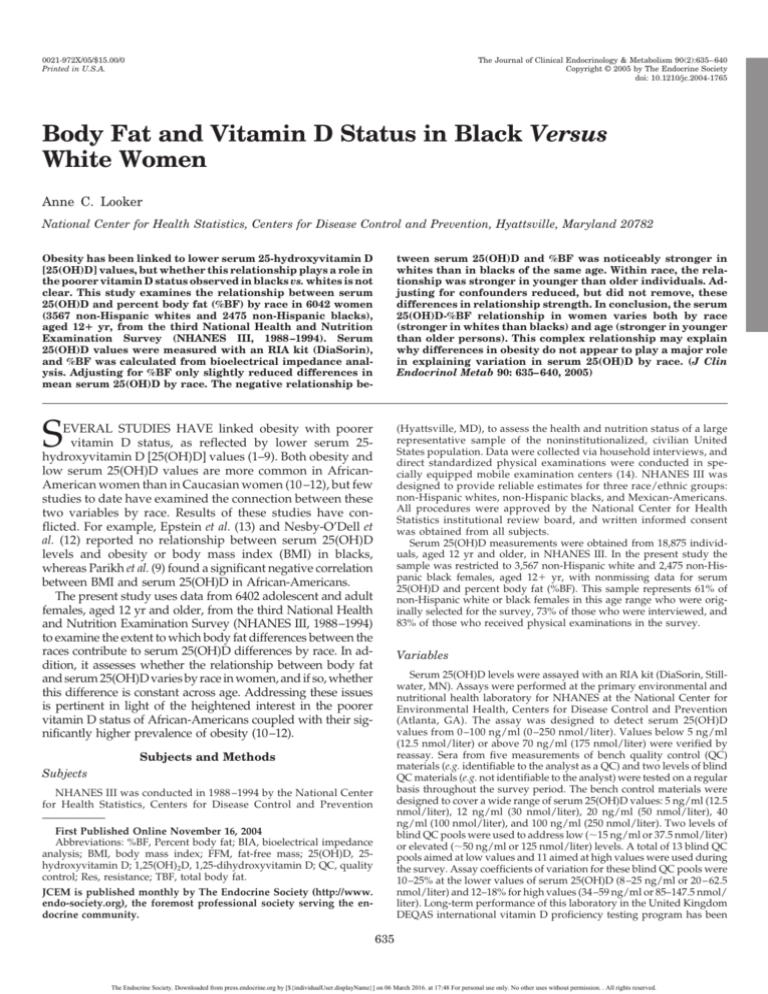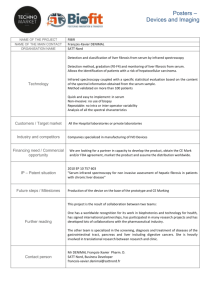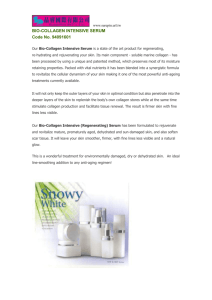
0021-972X/05/$15.00/0
Printed in U.S.A.
The Journal of Clinical Endocrinology & Metabolism 90(2):635– 640
Copyright © 2005 by The Endocrine Society
doi: 10.1210/jc.2004-1765
Body Fat and Vitamin D Status in Black Versus
White Women
Anne C. Looker
National Center for Health Statistics, Centers for Disease Control and Prevention, Hyattsville, Maryland 20782
Obesity has been linked to lower serum 25-hydroxyvitamin D
[25(OH)D] values, but whether this relationship plays a role in
the poorer vitamin D status observed in blacks vs. whites is not
clear. This study examines the relationship between serum
25(OH)D and percent body fat (%BF) by race in 6042 women
(3567 non-Hispanic whites and 2475 non-Hispanic blacks),
aged 12ⴙ yr, from the third National Health and Nutrition
Examination Survey (NHANES III, 1988 –1994). Serum
25(OH)D values were measured with an RIA kit (DiaSorin),
and %BF was calculated from bioelectrical impedance analysis. Adjusting for %BF only slightly reduced differences in
mean serum 25(OH)D by race. The negative relationship be-
tween serum 25(OH)D and %BF was noticeably stronger in
whites than in blacks of the same age. Within race, the relationship was stronger in younger than older individuals. Adjusting for confounders reduced, but did not remove, these
differences in relationship strength. In conclusion, the serum
25(OH)D-%BF relationship in women varies both by race
(stronger in whites than blacks) and age (stronger in younger
than older persons). This complex relationship may explain
why differences in obesity do not appear to play a major role
in explaining variation in serum 25(OH)D by race. (J Clin
Endocrinol Metab 90: 635– 640, 2005)
S
EVERAL STUDIES HAVE linked obesity with poorer
vitamin D status, as reflected by lower serum 25hydroxyvitamin D [25(OH)D] values (1–9). Both obesity and
low serum 25(OH)D values are more common in AfricanAmerican women than in Caucasian women (10 –12), but few
studies to date have examined the connection between these
two variables by race. Results of these studies have conflicted. For example, Epstein et al. (13) and Nesby-O’Dell et
al. (12) reported no relationship between serum 25(OH)D
levels and obesity or body mass index (BMI) in blacks,
whereas Parikh et al. (9) found a significant negative correlation
between BMI and serum 25(OH)D in African-Americans.
The present study uses data from 6402 adolescent and adult
females, aged 12 yr and older, from the third National Health
and Nutrition Examination Survey (NHANES III, 1988 –1994)
to examine the extent to which body fat differences between the
races contribute to serum 25(OH)D differences by race. In addition, it assesses whether the relationship between body fat
and serum 25(OH)D varies by race in women, and if so, whether
this difference is constant across age. Addressing these issues
is pertinent in light of the heightened interest in the poorer
vitamin D status of African-Americans coupled with their significantly higher prevalence of obesity (10 –12).
(Hyattsville, MD), to assess the health and nutrition status of a large
representative sample of the noninstitutionalized, civilian United
States population. Data were collected via household interviews, and
direct standardized physical examinations were conducted in specially equipped mobile examination centers (14). NHANES III was
designed to provide reliable estimates for three race/ethnic groups:
non-Hispanic whites, non-Hispanic blacks, and Mexican-Americans.
All procedures were approved by the National Center for Health
Statistics institutional review board, and written informed consent
was obtained from all subjects.
Serum 25(OH)D measurements were obtained from 18,875 individuals, aged 12 yr and older, in NHANES III. In the present study the
sample was restricted to 3,567 non-Hispanic white and 2,475 non-Hispanic black females, aged 12⫹ yr, with nonmissing data for serum
25(OH)D and percent body fat (%BF). This sample represents 61% of
non-Hispanic white or black females in this age range who were originally selected for the survey, 73% of those who were interviewed, and
83% of those who received physical examinations in the survey.
Variables
Serum 25(OH)D levels were assayed with an RIA kit (DiaSorin, Stillwater, MN). Assays were performed at the primary environmental and
nutritional health laboratory for NHANES at the National Center for
Environmental Health, Centers for Disease Control and Prevention
(Atlanta, GA). The assay was designed to detect serum 25(OH)D
values from 0 –100 ng/ml (0 –250 nmol/liter). Values below 5 ng/ml
(12.5 nmol/liter) or above 70 ng/ml (175 nmol/liter) were verified by
reassay. Sera from five measurements of bench quality control (QC)
materials (e.g. identifiable to the analyst as a QC) and two levels of blind
QC materials (e.g. not identifiable to the analyst) were tested on a regular
basis throughout the survey period. The bench control materials were
designed to cover a wide range of serum 25(OH)D values: 5 ng/ml (12.5
nmol/liter), 12 ng/ml (30 nmol/liter), 20 ng/ml (50 nmol/liter), 40
ng/ml (100 nmol/liter), and 100 ng/ml (250 nmol/liter). Two levels of
blind QC pools were used to address low (⬃15 ng/ml or 37.5 nmol/liter)
or elevated (⬃50 ng/ml or 125 nmol/liter) levels. A total of 13 blind QC
pools aimed at low values and 11 aimed at high values were used during
the survey. Assay coefficients of variation for these blind QC pools were
10 –25% at the lower values of serum 25(OH)D (8 –25 ng/ml or 20 – 62.5
nmol/liter) and 12–18% for high values (34 –59 ng/ml or 85–147.5 nmol/
liter). Long-term performance of this laboratory in the United Kingdom
DEQAS international vitamin D proficiency testing program has been
Subjects and Methods
Subjects
NHANES III was conducted in 1988 –1994 by the National Center
for Health Statistics, Centers for Disease Control and Prevention
First Published Online November 16, 2004
Abbreviations: %BF, Percent body fat; BIA, bioelectrical impedance
analysis; BMI, body mass index; FFM, fat-free mass; 25(OH)D, 25hydroxyvitamin D; 1,25(OH)2D, 1,25-dihydroxyvitamin D; QC, quality
control; Res, resistance; TBF, total body fat.
JCEM is published monthly by The Endocrine Society (http://www.
endo-society.org), the foremost professional society serving the endocrine community.
635
The Endocrine Society. Downloaded from press.endocrine.org by [${individualUser.displayName}] on 06 March 2016. at 17:48 For personal use only. No other uses without permission. . All rights reserved.
636
J Clin Endocrinol Metab, February 2005, 90(2):635– 640
excellent. Details of the assay method for this measurement have been
previously reported (15).
The %BF was calculated using bioelectrical impedance analysis (BIA)
data. A single, tetrapolar BIA measurement of resistance (Res) and
reactance at 50 kHz was taken between the right wrist and ankle while
the respondent was supine using a 1990B Bio-Resistance Body Composition Analyzer (Valhalla Scientific, San Diego, CA). Total body water
and fat-free mass (FFM) were calculated from Res measurements using
prediction equations that have been validated and published for
NHANES III previously (16). Because these equations were based on Res
data from RJL bioelectrical impedance analyzers (RJL, Clinton Township, MI), the NHANES III Res data had to be converted to RJL values
before applying the equations, as described previously (16). Estimates
of total body fat (TBF) and %BF were calculated as follows: TBF ⫽ FFM ⫺
body weight, and %BF ⫽ TBF/body weight. Body weight was measured
to the nearest 0.01 kg using an electronic load cell scale (14).
Race and ethnicity were self-reported by the participants. Several
additional variables were included in the study because previous studies
suggested that they were related to serum 25(OH)D (11, 12), and preliminary analyses indicated they were also related to body fat and race
and thus might confound the results of the present analysis. These
included the following variables. 1) The month of blood collection was
based on the date of the respondent’s physical examination. 2) Physical
activity was based on self-reported times per month that the respondent
performed exercise that made him/her sweat for subjects aged 12–16 yr;
for subjects aged 17 yr and older, it was based on self-reported times per
month of performing various activities (walking a mile or more without
stopping, jogging or running, bicycling, swimming, aerobics or aerobic
dancing, other dancing, calisthenics or exercise, gardening or yard work,
weight lifting, or other exercises, sports, or physically active hobbies).
All activities for adults were included in the main analyses to be more
comparable with the physical activity item for adolescents, which could
not be separated into outdoor vs. indoor activities. Secondary analyses
were performed for adults using only those activities likely to be performed outdoors (walking, jogging, or running; bicycling; swimming;
and gardening and yard work) to compare with results based on all
activities. 3) Dietary vitamin D intake from food was based on a single
24-h recall. The University of Minnesota Nutrition Coordinating Center
food composition database was used for the vitamin D composition data
(17, 18). 4) The frequency of milk consumption was based on selfreported times per month that the respondents drank milk or added it
to cereal; cereal consumption was based on times per month that cold
cereal was consumed. 5) Smoking was based on responses to questionnaire items asking whether the respondent had ever smoked at least 100
cigarettes and, if so, whether he/she currently smoked. Responses to
these items were combined to identify current smoker or former smokers
vs. never smokers. 6) Vitamin-mineral supplement use was based on a
questionnaire item that asked whether the respondents had taken any
vitamin or mineral supplements in the past month. 7) Current oral
contraceptive or hormone therapy use were based on questionnaire
items that asked about the use of birth control pills or estrogen (pills,
cream, suppository, injection, or patch).
Data analyses
Sample weights were used when calculating point estimates. The use
of these weights provides estimates representative of the civilian, noninstitutionalized U.S. population at the time of NHANES III; the weights
also account for oversampling and nonresponse in the survey. The
analyses were performed using SUDAAN (19), a family of statistical
procedures for analysis of data from complex sample surveys. Potential
confounding variables were identified using regression or 2 analyses.
Because responses to the physical activity variable were skewed, these
data were analyzed after performing a log transformation. Age-adjusted
means of the various confounding variables were calculated and compared between the two races using regression.
Regression analysis was also used to assess the effect of adjusting for
body fat differences on racial differences in serum 25(OH)D values by
calculating mean serum 25(OH)D values by race before and after adjusting for %BF. Age-adjusted mean serum 25(OH)D levels were also
compared by quartile of %BF in white vs. black women. Finally, regression analyses were used to examine the relationship between serum
Looker • Body Fat and Serum 25(OH)D by Race
25(OH)D and body fat separately by race and age before and after
adjusting for the confounding variables.
Several secondary analyses were also performed to address potential
limitations in the study. For example, because BIA only provides an
indirect measure of %BF, the analyses described above were repeated
using BMI. Analyses were also repeated after restricting the sample to
those examined between November and March (when UV radiation
levels are low) as an additional way to address the unequal distribution
of month of blood collection between blacks and whites (11). Analyses
in which confounders were controlled were repeated for adults after
restricting the physical activity variable to only those activities that were
more likely to be performed outdoors, as a means of better assessing
possible differences in sun exposure. To explore the serum 25(OH)D%BF relationship by age in more depth, analyses were performed in
whites after dividing the 50⫹ yr group into 50 – 64 and 65⫹ yr groups.
Finally, physical activity levels were compared in obese individuals by
race and age to assess whether potential sun avoidance by obese individuals varied by these factors.
A secondary analysis was also conducted to assess the extent to which
differences in the serum 25(OH)D-body fat relationship by race were
affected by the smaller variation in serum 25(OH)D distribution observed in black women. In this analysis, the relationship was examined
in white women after restricting the sample to those with serum
25(OH)D values that fell between 6.7 and 42.5 ng/ml (16.8 –106.3 nmol/
liter); these values correspond to the 1st and 99th percentiles of the serum
25(OH)D distribution of the black women.
Results
Sample sizes by age and age-adjusted means or prevalences of selected confounding variables by race are shown
in Table 1 for the study sample. Non-Hispanic black women
were younger and had more body fat than white women.
They had lower intakes of vitamin D from food, as assessed
TABLE 1. Selected characteristics of the sample by race/ethnicity
Variable
Non-Hispanic
white women
Non-Hispanic
black women
n
Sample size by age (yr)
12–29
30 – 49
50 – 69
70⫹
788
970
886
923
925
909
458
183
Mean
Age (yr)
% BFb
Physical activity (times/month)b,c
Dietary vitamin D (g/d)b
Milk consumption (times/month)b
Cereal consumption (times/month)b
a
38.9a
37.4a
13.1a
3.31a
15.4a
8.7a
43.9
33.9a
15.2a
4.42a
25.0a
10.4a
%
b
Smoking
Current/former
Never
Vitamin-mineral supplement useb
Yes
No
Current oral contraceptive or
hormone therapy useb
Yes
No
Month of blood collectionb
November–March
April–October
48.4a
51.6
36.9a
63.1
47.7a
52.3
35.1a
64.9
21.3a
78.7
14.7a
85.3
28.1a
71.9
43.5a
56.5
P ⬍ 0.05 for non-Hispanic white vs. non-Hispanic black.
Adjusted for age.
c
Geometric mean.
a
b
The Endocrine Society. Downloaded from press.endocrine.org by [${individualUser.displayName}] on 06 March 2016. at 17:48 For personal use only. No other uses without permission. . All rights reserved.
Looker • Body Fat and Serum 25(OH)D by Race
J Clin Endocrinol Metab, February 2005, 90(2):635– 640
by a single 24-h recall, as well as lower usual intakes of two
food sources of vitamin D, milk and cereal. They were more
likely to be nonsmokers than white women, but less likely to
perform physical activity or use vitamin-mineral supplements or female hormones. Finally, they were more likely to
have had their blood collected during November-March; this
occurred because NHANES collects data in the south during
the winter (because the mobile exam centers are not designed
for cold weather operation), and the majority of African
Americans live in the south [⬃62% in 1990 according to data
from the U.S. Census Bureau (20)].
Table 2 compares mean serum 25(OH)D values by race
before and after adjusting for %BF. Mean serum 25(OH)D
values were 1.4 –1.9 times higher in white women than in
black women before adjusting for %BF. Adjusting for %BF
reduced, but did not remove, the white/black difference;
serum 25(OH)D values remained 1.3–1.9 times higher in
whites. The lack of impact of %BF on racial differences in
serum 25(OH)D is also evident by the consistent difference
in age-adjusted mean serum 25(OH)D levels in white vs.
black women in the different %BF quartiles (Fig. 1). The ratio
of white/black means was 1.7 in the first three quartiles and
1.5 in the fourth, or highest, quartile of %BF.
To explore the basis for the lack of impact of body fat on
racial differences in serum 25(OH)D, a regression of serum
25(OH)D on %BF was performed separately by race after
adjusting for age or for all confounders. Results are shown
in Table 3. %BF was significantly related to serum 25(OH)D
in white women regardless of age, but among black women,
the relationship was significant only among women less than
50 yr of age. Furthermore, the  coefficients for the relationship in white women were approximately 3–7 times larger
than those in black women, indicating that the strength of the
relationship is greater in whites than in blacks.
The strength of the relationship also varied by age within
race, as suggested by the smaller  coefficients for women
ages 50⫹ yr relative to those for the younger women in both
races (Table 3). The lack of statistically reliable estimates for
older black women precluded firm conclusions about the age
relationship among blacks, but among white women,  coefficients were approximately 2–3 times higher in those ages
12– 49 yr than in those over age 50 yr either before or after
adjusting for other confounding variables. Additional exploTABLE 2. Mean serum 25(OH)D by race/ethnicity in women
before and after adjusting for %BF
Age and adjustment
factors
12–29 yr
Unadjusted
Adjusted for
30 – 49 yr
Unadjusted
Adjusted for
50 – 69 yr
Unadjusted
Adjusted for
70⫹ yr
Unadjusted
Adjusted for
Non-Hispanic
white
Non-Hispanic
black
White/black
ratio
%BF
35.43
35.26
18.25
18.87
1.9
1.9
%BF
30.99
30.72
17.12
18.88
1.8
1.6
%BF
27.30
27.30
19.99
20.40
1.4
1.3
%BF
26.38
26.36
19.28
19.50
1.4
1.4
Values are expressed as nanograms per milliliter. To convert serum 25(OH)D to nanomoles per liter, multiply by 2.5.
637
FIG. 1. Age-adjusted mean serum 25(OH)D (nanograms per milliliter) by %BF quartile in non-Hispanic white or black females, aged
12⫹ yr. To convert serum 25(OH)D values to nanomoles per liter,
multiply by 2.5. 䡺, Non-Hispanic white; f, non-Hispanic black.
ration of the relationship in older white women revealed a
tendency for the relationship to continue to weaken with age,
as suggested by the larger  coefficient for women ages
50 – 64 yr ( ⫽ ⫺0.18; P ⫽ 0.09) than for women ages 65⫹ yr
(⫽ ⫺0.07; P ⫽ 0.64).
Results of the secondary analyses of body fat and serum
25(OH)D performed to address various potential study limitations (e.g. use BMI instead of %BF, restrict sample to winter
only, or restrict physical activity to likely outdoor activities)
were similar to those obtained in the main analyses (data not
shown). In addition, the frequency of physical activity did
not differ in obese individuals by race or age (data not
shown); this analysis was performed to assess whether sun
avoidance in obese subjects might vary by these factors.
Finally, results of the analysis performed to assess whether
the smaller variation in serum 25(OH)D values among blacks
accounted for its weaker relationship with body fat in this
group suggested that this was not the case. Specifically, the
 coefficient for %BF remained noticeably higher for white
women ( ⫽ ⫺0.22) than for black women ( ⫽ ⫺0.10) even
after restricting the sample to white women with serum
25(OH)D values that fell between the 1st and 99th percentiles
of the serum 25(OH)D distribution of the black women.
Discussion
Recent concerns have been raised about the high prevalence of low serum 25(OH)D values observed in AfricanAmericans (12). The lower values observed in African-Americans have been attributed primarily to reduced synthesis of
vitamin D in the skin due to greater skin pigmentation (21).
Although differences in skin synthesis due to melanin undoubtedly play a major role in racial differences in serum
25(OH)D, other factors may also contribute. Obesity is of
particular interest, given its link to lower serum 25(OH)D
values and the fact that the prevalence of obesity is significantly higher in African-American women than in white
women (10). However, to date, few studies have examined
whether obesity is linked to the lower serum 25(OH)D levels
in African-Americans, and these have produced conflicting
results (9, 12, 13).
The present study found that adjusting for body fat differences did not noticeably reduce the differences in serum
25(OH)D levels between white and black women in any of
the age groups examined. Subsequent analyses of the relationship between serum 25(OH)D and %BF within race/
ethnic groups highlighted a likely explanation for this lack of
The Endocrine Society. Downloaded from press.endocrine.org by [${individualUser.displayName}] on 06 March 2016. at 17:48 For personal use only. No other uses without permission. . All rights reserved.
638
J Clin Endocrinol Metab, February 2005, 90(2):635– 640
Looker • Body Fat and Serum 25(OH)D by Race
TABLE 3. Relationship between serum 25(OH)D and %BF by race/ethnicity and age
Regression of serum 25(OH)D on %BF
Age and race
12–29 yr
Non-Hispanic
Non-Hispanic
30 – 49 yr
Non-Hispanic
Non-Hispanic
50⫹ yr
Non-Hispanic
Non-Hispanic
Adjusted for all confoundersa
Adjusted for age
White/black
ratio
 coefficient
P
0.0000
0.0001
3.0
⫺0.3192
⫺0.1117b
0.0000
0.0417
2.9b
⫺0.4754
⫺0.1302
0.0000
0.0000
3.7
⫺0.3721
⫺0.1326
0.0000
0.0007
2.8
⫺0.1642
0.0286b
0.0002
0.5997
5.7b
⫺0.1854
0.0273b
0.0001
0.7721
6.8b
 coefficient
P
white
black
⫺0.3838
⫺0.1277
white
black
white
black
White/black
ratio
a
Age, physical activity, month of blood collection, smoking, oral contraceptive or hormone use, micrograms of dietary vitamin D per day,
frequency of milk or cereal consumption, and vitamin-mineral supplement use.
b
May be unreliable (SE/ coefficient ⬎ 0.30).
effect, namely, that serum 25(OH)D is only weakly related to
%BF in blacks.
More importantly, the present study suggests the relationship between serum 25(OH)D and body fat in women is
complex overall, e.g. it depends on both race and age. In
specific, the relationship is stronger in whites than in blacks
at all ages. In addition, there is divergence by age within race;
we found a significant, although weak, relationship among
younger black women, but no relationship among older
black women. The divergence in strength by age was also
observed in white women, although the relationship remained statistically significant in older white women, aged
50⫹ yr.
The reason for the weaker relationship between body fat
and serum 25 (OH)D in blacks is not clear. Wortsman et al.
(7) recently proposed that the lower serum 25(OH)D levels
seen among obese whites was the result of increased sequestration of vitamin D in fat tissue. Whether this applies to
blacks is uncertain. On the one hand, differences in fat metabolism observed by race [enhanced lipogenesis and reduced lipolysis in blacks (22–24)] seem more consistent with
blacks having a greater ability to sequester vitamin D than
whites, which should lead to a stronger body fat-vitamin D
relationship in blacks. On the other hand, blacks have reduced synthesis of vitamin D in the skin due to the presence
of more melanin, which absorbs the UV radiation needed for
the skin synthesis to occur (21). Skin synthesis of vitamin D
has been estimated to account for the majority of vitamin D
in the human body (25). Thus, it is possible that body fat has
a lower impact in blacks because there is less vitamin D
formed in the skin to sequester.
Other mechanisms proposed to explain the link between
obesity and serum 25(OH)D in whites include greater avoidance of the sun by obese persons (3), and negative feedback
control on hepatic synthesis of serum 25(OH)D due to higher
levels of serum 1,25-dihydroxyvitamin D [1,25(OH)2D] in the
obese (1). Sun avoidance could play a role in the differences
in the body fat-serum 25(OH)D relationship by race if, for example, obese blacks were more likely to avoid the sun than
obese whites. However, in the present study, self-reported
physical activity levels did not differ significantly between
obese whites and blacks, which is not consistent with that possibility. Serum 1,25(OH)2D was not measured in NHANES III,
so its potential role in differences in the body fat-serum
25(OH)D relationship by race could not be evaluated in the
present study. However, there are data to suggest racial differences occur in the relationship between serum 1,25(OH)2D
and obesity. Epstein et al. (13) reported that serum 1,25(OH)2D
values did not differ by obesity status in blacks, which suggests
that feedback from serum 1,25(OH)2D on hepatic synthesis of
serum 25(OH)D might be affected less by obesity status in
blacks than in whites. However, their study sample was small
(12 nonobese and 10 obese blacks) and may have lacked the
statistical power needed to detect a difference.
In the present study, the serum 25(OH)D-body fat relationship was also weaker in older individuals relative to
younger subjects of the same race. The mechanisms outlined
above for the racial difference in this relationship may also
apply to the age-related difference. For example, older individuals have a reduced ability to synthesize vitamin D in
the skin (26), which could result in less vitamin D available
to sequester. Another possibility, e.g. differences in sun
avoidance in older vs. younger obese persons, does not appear to explain the findings in the present study, because
self-reported physical activity levels did not differ significantly between obese younger vs. older persons when analyzed in broad age groups among whites. Whether differences in serum 1,25(OH)2D levels by age play a role is harder
to assess, given the complex age patterns displayed by this
variable; levels appear to increase up until age 65 yr, then
decline (27). The present study could not directly examine the
role of 1,25(OH)2D, but the serum 25(OH)D-%BF relationship was noticeably weaker in white women aged 65⫹ yr [in
whom serum 1,25(OH) 2D values are presumably lower] than
in white women aged 50 – 64 yr, which is not consistent with
higher serum 1,25(OH)2D levels explaining age differences in
this relationship. More work is clearly needed to better understand the mechanisms underlying the differences in the
relationship between body fat and serum 25(OH)D by age as
well as by race.
The present study has several limitations, including the
use of %BF estimates based on BIA. BIA does not directly
measure body fat; instead, it measures total body water, from
which FFM and fat mass are subsequently derived using
prediction equations. An NIH panel concluded that BIA was
useful for body composition analysis in most individuals
The Endocrine Society. Downloaded from press.endocrine.org by [${individualUser.displayName}] on 06 March 2016. at 17:48 For personal use only. No other uses without permission. . All rights reserved.
Looker • Body Fat and Serum 25(OH)D by Race
who do not have conditions with major disturbances in body
water (28), but they also noted that the validity of the FFM
and fat mass estimates depends on the validity of the prediction equations. An extensive study was undertaken to
develop and evaluate prediction equations for the BIA data
collected in NHANES III; this multicenter study used a multicompartment model to assess body composition in more
than 1800 individuals (16). The evaluation indicated that the
equations have excellent precision overall, but they did not
perform as well in blacks as in whites (16). In specific, total
body water and FFM were underpredicted in blacks; this
systematic difference could affect comparisons between
races (29). Two approaches were used to address the potential impact of this difference: 1) the relationship between %BF
and serum 25(OH)D values was examined separately within
each racial group as part of the main analyses in the present
study, because, according to Chumlea et al. (29), the NHANES
III body composition estimates from BIA are probably adequate
for comparisons within racial groups; and 2) the relationship
between body fat and serum 25(OH)D was assessed in secondary analyses using BMI rather than %BF. Results from both
sets of analyses supported the finding of a reduced relationship
between body fat and serum 25(OH)D in blacks.
Other limitations include differences in the season during
which blood was collected by race, with more blacks having
blood collected in the winter. However, we controlled for
month of blood collection in all main analyses, and the results
of the secondary analysis in which the sample was restricted
to those with blood collected in winter were similar to the
main analyses as well. NHANES III also lacks data on sun
exposure and serum 1,25(OH)2D. Physical activity level was
used as a proxy for sun exposure in the present study, but
it is only an approximation in light of the inability to define
outdoor activities with certainty and the fact that sun exposure during nonleisure physical activity is not assessed.
There is also potential for nonresponse bias in the sample,
because not all of those who were selected to participate in
the survey did so. Nonresponse bias in the sample that came
to the mobile exam centers in NHANES III is reduced to some
extent by a nonresponse adjustment factor included in the
calculation of the sample weights (30). After applying these
weighting adjustments, differences between examinees and
nonexaminees were minor (30). However, about 17% of the
eligible women who came to the mobile exam centers did not
have usable serum 25(OH)D data, and this nonresponse is
not addressed by the sample weight adjustments.
In conclusion, the relationship between body fat and serum 25(OH)D in women is complex; it is weaker in blacks
than in whites, and within race, it is weaker in older than in
younger subjects. Thus, it appears to depend on both race
and age. The weaker relationship in African-Americans
probably explains why the higher body fat levels in black
women did not appear to play a major role in explaining their
lower serum 25(OH)D values relative to those in white
women. More work is needed to identify the mechanisms
that underlie these variations in the relationship between
body fat and vitamin D status.
J Clin Endocrinol Metab, February 2005, 90(2):635– 640
639
Acknowledgments
Received September 3, 2004. Accepted November 4, 2004.
Address all correspondence to: Dr. Anne C. Looker, Room 4310,
National Center for Health Statistics, 3311 Toledo Road, Hyattsville,
Maryland 20782. E-mail: acl1@cdc.gov.
A portion of this work was presented at the 26st Annual American
Society for Bone and Mineral Research Meeting, Seattle, WA, October,
2004.
References
1. Bell NH, Epstein S, Greene A, Shary J, Oexmann MJ, Shaw S 1985 Evidence
for alteration of the vitamin D-endocrine system in obese subjects. J Clin Invest
76:370 –373
2. Liel Y, Ulmer E, Shary J, Hollis BW, Bell NH 1988 Low circulating vitamin
D in obesity. Calcif Tissue Int 43:199 –201
3. Compston JE, Vedi S, Ledger JE, Webb A, Gazet JC, Pilkington TRE 1981
Vitamin D status and bone histomorphometry in gross obesity. Am J Clin Nutr
34:2359 –2363
4. Hey H, Stockholm KH, Lund BJ, Sorenson OH 1982 Vitamin D deficiency in
obese patients and changes in circulating vitamin D metabolites following
jejunoileal bypass. Int J Obes 6:473– 479
5. Hyldstrup L, Andersen T, McNair P, Breum L, Transbol I 1993 Bone metabolism in obesity: changes related to severe overweight and dietary weight
reduction. Acta Endocrinol (Copenh) 129:393–398
6. Buffington C, Walker B, Cowan GS, Scruggs D 1993 Vitamin D deficiency in
morbidly obese. Obes Surg 3:421– 424
7. Wortsman J, Matsuoka LY, Chen TC, Lu Z, Holick MF 2000 Decreased
bioavailability of vitamin D in obesity. Am J Clin Nutr 72:690 – 693
8. Arunabh S, Pollack S, Yeh J, Aloia JF 2003 Body fat content and 25hydroxyvitamin D levels in healthy women. J Clin Endocrinol Metab 88:
157–161
9. Parikh SJ, Edelman M, Uwaifo GI, Freedman RJ, Semega-Janneh M, Reynolds J, Yanovski J 2004 The relationship between obesity and serum 1,25dihydroxy vitamin D concentrations in healthy adults. J Clin Endocrinol Metab
89:1196 –1199
10. Hedley AA, Ogden CL, Johnson CL, Carroll MD, Curtin LR, Flegal KM 2004
Prevalence of overweight and obesity among US children, adolescents and
adults 1999 –2002. JAMA 291:2847–2850
11. Looker AC, Dawson-Hughes B, Calvo MS, Gunter EW, Sahyoun NR 2002
Serum 25-hydroxyvitamin D status of adolescents and adults in two seasonal
subpopulations from NHANES III. Bone 30:771–777
12. Nesby-O’Dell S, Scanlon KS, Cogswell ME, Gillespie C, Hollis BW, Looker
AC, Allen C, Doughertly C, Gunter EQ, Bowman BA 2002 Hypovitaminosis
D prevalence and determinants among African American and white women
of reproductive age: third National Health and Nutrition Examination Survey
1988 –94. Am J Clin Nutr 76:187–192
13. Epstein S, Bell NH, Shary J, Shaw S, Greene A, Oexmann MJ 1986 Evidence
that obesity does not influence the vitamin D-endocrine system in blacks.
J Bone Miner Res 1:181–184
14. National Center for Health Statistics 1994 Plan and operation of the third
National Health and Nutrition Examination Survey, 1988 –94. Vital Health Stat
1(32); DHHS publication (PHS) 94-1308. Hyattsville, MD: National Center
for Health Statistics (available at http://www.cdc.gov/nchs/about/major/
nhanes/NHANESIII_Reference_Manuals.htm, accessed 7/20/2004)
15. Gunter EW, Lewis BL, Koncikowski SM 1996 Laboratory methods used for
the third National Health and Nutrition Examination Survey (NHANES III),
1988 –1994. Hyattsville, MD: Centers for Disease Control and Prevention
(available at http://www.cdc.gov/nchs/about/major/nhanes/NHANESIII_
Reference_Manuals.htm, accessed 7/20/2004)
16. Sun SS, Chumlea WC, Heymsfield SB, Lukaski HC, Schoeller D, Friedl K,
Kuczmarski RJ, Flegal KM, Johnson CL, Hubbard VS 2003 Development of
bioelectrical impedance analysis prediction equations for body composition
with the use of a multicomponent model for use in epidemiologic surveys.
Am J Clin Nutr 77:331–340
17. University of Minnesota, Nutrition Coordinating Center 1996 Nutrient database versions 15–27. Minneapolis: University of Minnesota
18. Buzzard IM, Feskanich D 1987 Maintaining a food composition data base for
multiple research studies: the NCC food table. In: Rand WM, ed. Food composition data: a user’s perspective. Tokyo: United Nations University; 115–122
19. Shah BV, Barnwell BG, Hunt PN, LaVange LM 1991 SUDAAN USER’S
MANUAL, Release 5.50. Research Triangle Park, NC: Research Triangle Institute
20. U.S. Department of Commerce, Economics and Statistics Administration,
Bureau of the Census 1993 We the Americans: blacks. WE-1; Washington DC:
U.S. Government Printing Office (available at: http://www.census.gov/apsd/
www/wepeople.html, accessed 10/14/2004)
21. Matsuoka LY, Wortsman J, Haddad JG, Kolm P, Hollis BW 1991 Racial
pigmentation and the cutaneous synthesis of vitamin D. Arch Dermatol 127:
536 –538
The Endocrine Society. Downloaded from press.endocrine.org by [${individualUser.displayName}] on 06 March 2016. at 17:48 For personal use only. No other uses without permission. . All rights reserved.
640
J Clin Endocrinol Metab, February 2005, 90(2):635– 640
22. Bower JF, Vadlamudi S, Barakat HA 2002 Ethnic differences in in vitro
glyceride synthesis in subcutaneous and omental adipose tissue. Am J Physiol
283:E988 –E993
23. Racette SB, Horowitz JF, Mittendorfer B, Klein S 2000 Racial differences in lipid
metabolism in women with abdominal obesity. Am J Physiol 279:R944 –R950
24. Barakat H, Hickner RC, Privette J, Bower J, Hao E, Udupi V, Green A, Pories
W, MacDonald K 2002 Differences in lipolytic function of adipose tissue
preparations from black American and Caucasian women. Metabolism 51:
1514 –1518
25. Holick MF 1994 McCollum Award Lecture. Vitamin D: new horizons for the
21st century. Am J Clin Nutr 60:619 – 630
26. MacLaughlin J, Holick MF 1985 Aging decreases the capacity of human skin
to produce vitamin D3. J Clin Invest 76:1536 –1538
Looker • Body Fat and Serum 25(OH)D by Race
27. Riggs BL 2003 Role of the vitamin D-endocrine system in the pathophysiology
of postmenopausal osteoporosis. J Cell Biochem 88:209 –215
28. National Institutes of Health 1994 Bioelectrical impedance analysis in body
composition measurement. Technology Assessment Conference Statement,
December12–14,1994(availableathttp://consensus.nih.gov/ta/015/015_intro.
htm, accessed 7/20/2004)
29. Chumlea WC, Guo SS, Kuczmarksi RJ, Flegal KM, Johnson CL, Heymsfield
SB, Lukaski HC, Friedl K, Hubbard VS 2002 Body composition estimates
from NHANES III bioelectrical impedance data. Int J Obes Relat Metab Disord
26:1596 –1609
30. Ezzati T, Khare M 1992 Nonresponse adjustments in a national health survey.
Proc of the American Statistical Association, Section on Survey Research Methods, Alexandria, VA, 1992, pp 339 –344
JCEM is published monthly by The Endocrine Society (http://www.endo-society.org), the foremost professional society serving the
endocrine community.
The Endocrine Society. Downloaded from press.endocrine.org by [${individualUser.displayName}] on 06 March 2016. at 17:48 For personal use only. No other uses without permission. . All rights reserved.





